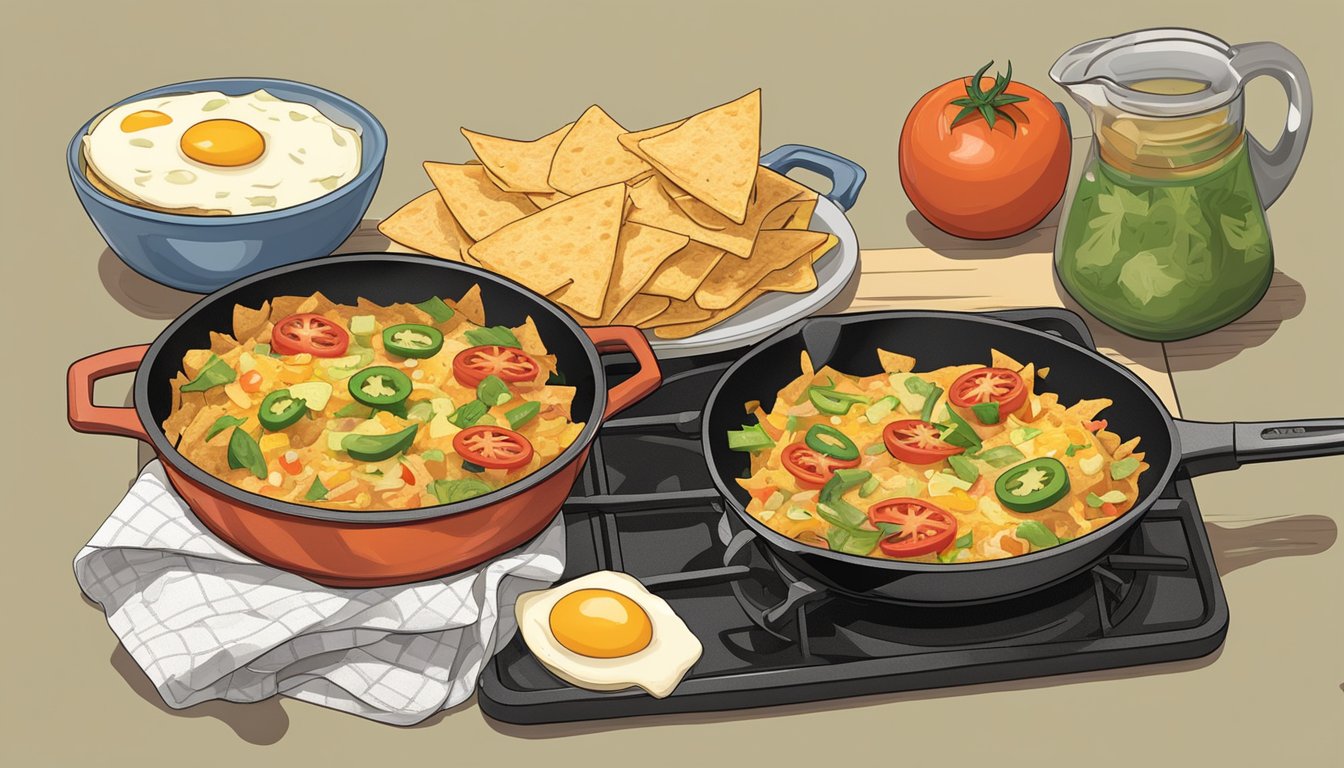Migas, a beloved Tex-Mex breakfast dish, combines crispy tortilla strips with scrambled eggs and flavorful additions. The best breakfast migas recipe starts with fresh corn tortillas, cut into small squares and fried until golden brown. This creates a satisfying crunch that contrasts beautifully with the soft, fluffy eggs.
A stellar migas recipe incorporates diced onions, bell peppers, and jalapeños sautéed until tender. These aromatic vegetables infuse the dish with authentic Mexican flavors. The eggs are then whisked with milk, cumin, salt, and pepper before being poured into the skillet with the vegetables and crispy tortilla pieces.
To elevate the dish, many cooks add a blend of shredded Cheddar and Monterey Jack cheeses. The result is a hearty, satisfying breakfast that showcases the perfect balance of textures and tastes. Migas serves as an excellent introduction to Tex-Mex cuisine, offering a delicious twist on traditional scrambled eggs.
History and Origin of Migas
Migas, a beloved breakfast dish, has roots in both Spanish and Mexican culinary traditions. The name “migas” translates to “crumbs” in English, reflecting its humble origins as a way to use leftover bread or tortillas.
In Spain, migas originated as a shepherd’s meal, utilizing stale bread as the main ingredient. This version typically includes garlic, olive oil, and pork products like chorizo or bacon.
The Mexican and Tex-Mex variations of migas evolved from this concept but incorporated corn tortillas instead of bread. These versions gained popularity in Texas and other parts of the southwestern United States.
Authentic Mexican migas often feature crispy tortilla strips scrambled with eggs, onions, tomatoes, and chili peppers. Tex-Mex migas builds on this foundation, sometimes adding cheese and additional vegetables.
It’s important to note the distinction between migas and chilaquiles, another popular Mexican breakfast dish. While both use tortillas, chilaquiles involve lightly fried tortilla pieces simmered in salsa, topped with eggs or meat.
Migas has become a staple in many Tex-Mex restaurants and households, appreciated for its flavorful combination of textures and its ability to transform simple ingredients into a satisfying meal.
Essential Ingredients

Migas relies on a handful of key components to create its signature flavor and texture. The right combination of ingredients elevates this Tex-Mex breakfast dish from ordinary to extraordinary.
Eggs and their Importance in Migas
Eggs form the foundation of migas, providing protein and binding the other ingredients together. Use fresh, large eggs for best results. Whisk them thoroughly to ensure even cooking and a fluffy texture.
Scramble the eggs gently over medium heat, folding in the other ingredients as they cook. This technique creates pockets of flavor throughout the dish.
For added richness, some chefs incorporate a splash of milk or cream into the egg mixture before cooking.
Tortillas: Corn vs Flour
Corn tortillas are the traditional choice for authentic migas. Cut them into small strips or squares before frying until crisp. This step adds a satisfying crunch and distinctive corn flavor to the dish.
Flour tortillas can be used as an alternative, though they produce a softer texture. Some cooks prefer a mix of both corn and flour for varied consistency.
For a time-saving shortcut, store-bought tortilla chips can be substituted, though they may lack the freshness of homemade fried tortillas.
Variety of Vegetables Used
A mix of vegetables adds color, flavor, and nutrition to migas. Common choices include:
- Onions: Diced white or yellow onions provide a savory base
- Tomatoes: Fresh diced tomatoes add juiciness and acidity
- Bell peppers: Red or green peppers contribute sweetness and crunch
- Jalapeños: Minced jalapeños bring heat (remove seeds for milder flavor)
Sauté vegetables briefly before adding eggs to soften them slightly while maintaining some texture. Garlic is often included for additional depth of flavor.
Some recipes incorporate cilantro for a fresh, herbal note. Add it at the end of cooking to preserve its bright flavor.
Cheeses and Toppings
Cheese is a crucial element in migas, melting into the eggs and adding richness. Monterey Jack is a popular choice for its mild flavor and excellent melting properties. Cheddar or queso fresco offer tasty alternatives.
Sprinkle grated cheese over the eggs as they finish cooking, allowing it to melt slightly.
Common toppings to serve alongside or on top of migas include:
- Sliced avocado
- Fresh salsa or pico de gallo
- Sour cream
- Extra cilantro
These additions provide contrasting textures and flavors, enhancing the overall dish. Season migas with kosher salt to taste, adjusting based on the saltiness of the cheese and tortillas used.
Preparation Techniques

Mastering key preparation techniques elevates migas from a simple dish to a breakfast delight. Proper cooking methods and smart use of leftovers are essential for achieving the perfect texture and flavor.
Cooking Methods
Start by heating oil in a cast iron skillet over medium-high heat. Tear corn tortillas into bite-sized pieces and fry until golden and crispy, about 2-3 minutes. Remove and drain on paper towels. In the same skillet, sauté diced onions, bell peppers, and jalapeños until tender.
Beat eggs in a separate bowl and season with salt and pepper. Pour the eggs into the skillet with the vegetables and add the crispy tortilla pieces. Stir gently to combine, cooking until the eggs are set but still moist.
For added flavor, sprinkle shredded cheese over the migas just before serving. The residual heat will melt the cheese perfectly.
Using Leftovers Effectively
Migas excel at transforming leftover ingredients into a delicious meal. Day-old corn tortillas work best, as they crisp up more easily than fresh ones. Simply tear them into small pieces before frying.
Leftover roasted vegetables, cooked meats, or even last night’s salsa can be incorporated into migas. Add these ingredients to the skillet after sautéing the fresh vegetables and before adding the eggs.
For a quick version, use pre-made tortilla chips instead of frying tortillas. Crush them slightly and add them to the eggs just before they finish cooking to maintain some crunch.
Customizing Your Migas
Migas offer endless possibilities for customization. Adapt this versatile dish to suit your tastes and dietary preferences with various ingredients and toppings.
Meat and Vegetarian Options
Chorizo adds a spicy, savory flavor to migas. Crumble and cook it before adding the eggs for a meaty twist. Bacon or diced ham are tasty alternatives. For vegetarians, plant-based chorizo or crumbled tofu work well.
Vegetables enhance nutrition and flavor. Diced bell peppers, onions, and tomatoes are classic additions. Spinach or kale provide a nutrient boost. Sautéed mushrooms offer an earthy taste.
Beans make migas more filling. Refried beans spread on tortillas before serving create a delicious base. Black beans mixed into the eggs add protein and texture.
Additional Toppings and Sides
Fresh toppings elevate migas. Pico de gallo adds brightness and crunch. Sliced avocado provides creaminess. Crumbled queso fresco or shredded cheddar cheese melt beautifully over hot migas.
Sauces complement the dish. Salsa verde offers tangy flavor. Hot sauce adds heat for spice lovers. Sour cream or Mexican crema cool things down.
Serve migas with warm corn or flour tortillas. A side of refried beans rounds out the meal. Fresh fruit balances the savory flavors.
For a twist, use migas as a filling for breakfast tacos or burritos. Top with extra cheese and broil for a crispy finish.
Serving and Presentation

Presenting migas attractively enhances the dining experience. Thoughtful plating and well-chosen accompaniments elevate this Tex-Mex breakfast dish from simple to spectacular.
Plating Techniques
Serve migas in a warm, shallow bowl or on a large plate. Mound the scrambled egg mixture in the center, creating height and visual interest. Sprinkle shredded cheese or crumbled queso fresco over the top, allowing it to melt slightly. Garnish with fresh cilantro leaves and sliced green onions for a pop of color.
For a rustic presentation, serve migas directly from the skillet. Place the hot pan on a wooden board or trivet at the table. This family-style approach encourages sharing and adds a casual, convivial atmosphere to the meal.
Accompaniments
Pair migas with warm corn or flour tortillas for wrapping. Offer a selection of salsas, such as pico de gallo, salsa verde, or a smoky chipotle sauce. Include sliced avocado or guacamole for creaminess and contrast.
Serve refried beans or black beans on the side for added protein and texture. A small bowl of sour cream provides a cool, tangy element. For those who enjoy extra heat, offer sliced jalapeños or hot sauce.
Transform migas into breakfast tacos by spooning the mixture into warm tortillas and topping with shredded cheese and salsa. This handheld option is perfect for a quick, portable meal.
Variant Recipes
Migas recipes vary widely across regions and culinary traditions. Different ingredients and techniques create unique flavor profiles and textures.
Tex-Mex Versus Traditional Mexican Migas
Tex-Mex migas typically include scrambled eggs, tortilla strips, cheese, and various vegetables. Onions, bell peppers, and jalapeños are common additions. Cheddar or Monterey Jack cheese often tops the dish.
Traditional Mexican migas focus on crispy tortilla strips as the star ingredient. Eggs play a supporting role, if used at all. Tomatoes, onions, and chile peppers provide flavor. Queso fresco or cotija cheese may garnish the dish.
Both versions often incorporate salsa or pico de gallo. Tex-Mex migas are usually served as a hearty breakfast, while Mexican migas can be enjoyed any time of day.
Creative Twists on the Classic
Innovative chefs and home cooks have developed unique migas variations. Some add chorizo or bacon for extra flavor and protein. Others incorporate avocado or black beans for a nutritious boost.
Vegetarian versions might use tofu scramble instead of eggs. Spinach, kale, or other leafy greens can add color and nutrients.
For a fusion twist, some recipes incorporate Asian flavors like soy sauce or sriracha. Others blend Mediterranean ingredients such as feta cheese and olives.
Chilaquiles, a similar dish, uses tortilla chips simmered in salsa instead of crispy strips. This creates a softer texture compared to traditional migas.
Practical Tips and Tricks
Use leftover corn tortillas for authentic texture. Tear them into 1-inch pieces before frying for even cooking.
Heat oil in a cast-iron skillet over medium-high heat. Test readiness by adding a tortilla piece – it should sizzle immediately.
Whisk eggs with a tablespoon of water for fluffier results. Add a pinch of ground cumin for extra flavor.
Cook vegetables before adding eggs. Sauté onions, bell peppers, and jalapeños for about 5 minutes until softened.
For cheesy migas, combine shredded cheddar and Monterey Jack. Add to eggs just before they set.
Garnish with fresh cilantro and serve immediately for the best taste and texture.
Migas make a fast, easy breakfast. Prep ingredients the night before to save time in the morning.
Experiment with toppings like avocado, salsa, or sour cream for variety.
Use vegetable or canola oil for frying. Olive oil can work but may alter the flavor slightly.
Season with kosher salt for better flavor distribution throughout the dish.




